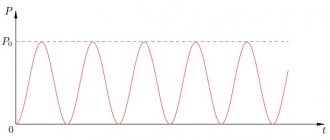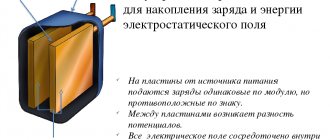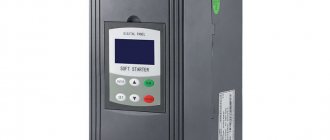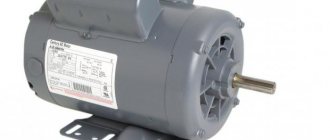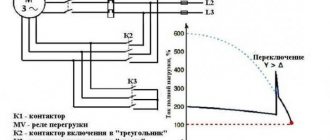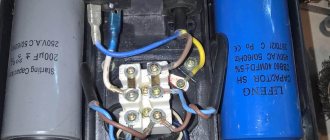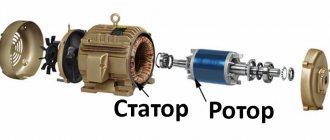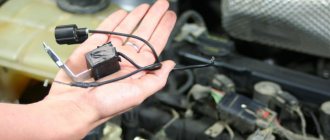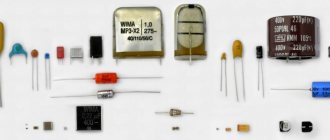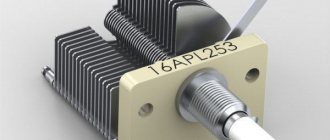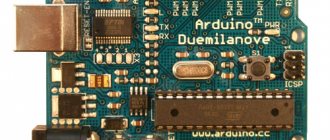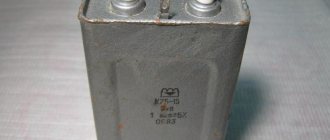Many owners quite often find themselves in a situation where they need to connect a device such as a three-phase asynchronous motor to various equipment in the garage or country house, which can be a sanding or drilling machine. This poses a problem, since the source is designed for single-phase voltage. What to do here? In fact, this problem is quite easy to solve by connecting the motor according to the circuits used for capacitors. To realize this idea, you will need a working and starting capacitor, often referred to as a phase-shifting capacitor.
Selecting the capacity of the working capacitor
To select the effective capacity of the device, it is necessary to perform calculations using the formula:
- I1 is the nominal value of the stator current, for measuring which special clamps are used;
- Umains – single-phase network voltage, (V).
After performing the calculations, you will get the capacitance of the working capacitor in microfarads.
It may be difficult for some to calculate this parameter using the above formula. However, in this case, you can use another scheme for calculating the capacity of the working capacitor, where you do not need to carry out such complex operations. This method allows you to quite simply determine the required parameter based only on the power of the asynchronous motor.
Here it is enough to remember that 100 watts of power
a three-phase motor should correspond to about 7 µF of the working capacitor.
In the process of calculating the capacitance for the working capacitor, you need to monitor the current that flows to the stator phase winding in the selected mode. It is considered unacceptable if the current is greater than the nominal value.
Selecting the capacitance of the starting capacitor
There are situations when the electric motor has to be turned on under conditions of heavy load on the shaft. Then one running capacitor will not be enough, so you will have to add a starting capacitor to it. The peculiarity of its operation is that it will only work during the engine starting period of no more than 3 seconds, for which the SA key is used
. When the rotor reaches the rated speed level, the device turns off.
If, through an oversight, the owner left the starting capacitors on, this will lead to the formation of a significant imbalance in the currents in the phases. In such situations, there is a high probability of engine overheating. When determining the capacitance, it should be assumed that the value of this parameter should be 2.5-3 times greater than the capacitance of the working capacitor. By acting in this way, it is possible to ensure that the starting torque of the engine reaches the nominal value, as a result of which no complications arise during its startup.
To create the required capacitance, capacitors can be connected in parallel or series circuits. You should keep in mind the operation of three-phase motors with a power of no more than 1 kW
allowed if they are connected to a single-phase network with a working capacitor. Moreover, here you can do without a starting capacitor.
Type selection
Having understood how to determine the capacitance of the working and starting capacitor, it is time to get acquainted with what type of capacitor can be used for the selected circuit
The best option is to use the same type for both capacitors. Typically, the operation of a three-phase motor is ensured by paper starting capacitors, enclosed in a sealed steel housing such as MPGO, MBGP, KBP or MBGO
.
Most of these devices are made in the form of a rectangle. If you look at the case, their characteristics are given there:
- Capacitance (uF);
- Operating voltage (V).
What type of stepper motor do I have?
If you manually rotate the rotor of a switched off engine, you will notice that it does not move smoothly, but in steps. After you have spun the rotor, short-circuit all the motor wires and spin the rotor again. If the rotor spins the same way, then you have a jet engine. If it takes more effort to rotate the rotor, then you have a permanent magnet or hybrid motor. You can distinguish a permanent magnet motor from a hybrid motor by counting the number of steps in one revolution. To do this, it is not necessary to count all the steps, it is enough to roughly understand whether there are less than 50 or more. If it is less, it means you have a permanent magnet motor, and if it is more, it means you have a hybrid motor.
Application of electrolytic devices
When using paper starting capacitors, you need to remember the following negative point: they are quite large in size, while providing a small capacity. For this reason, for efficient operation of a small-power three-phase motor, it is necessary to use a fairly large number of capacitors. If desired, paper capacitors can be replaced with electrolytic ones
. In this case, they must be connected in a slightly different way, where additional elements must be present, represented by diodes and resistors.
However, experts do not recommend using electrolytic starting capacitors. This is due to the presence of a serious drawback in them, which manifests itself in the following: if the diode does not cope with its task, alternating current will begin to be supplied to the capacitor, and this is fraught with its heating and subsequent explosion.
Another reason is that today on the market you can find improved polypropylene AC starting models of the SVV type with a metallized coating.
Most often they are designed to operate with a voltage of 400-450 V
. They should be given preference, given that they have repeatedly shown themselves to be good.
Working conditions
They are different for each capacitor. Since the first of them is permanently connected to the motor winding, this circuit forms an elementary oscillatory circuit. Because of this, at certain moments a voltage is formed at its terminals that exceeds the input voltage by two and a half to three times. This circumstance should be taken into account when selecting; you need to focus on parts designed for 500-600 volts.
Starting capacitors for electric motors - 220 V operate under other, less severe conditions, unlike working ones. The voltage applied to this capacitive element exceeds the main voltage by approximately 1.15 times. It is attached to the circuits from time to time, which also has a positive effect on its operating conditions and significantly extends its service life.
The most commonly used are domestic paper or oil-filled capacitors of the MBGO or MBGCh brands. Their advantage is their resistance to high AC voltages. But there is also a drawback - its large size. As an alternative solution, oxide capacitors can be used. They are connected not directly, but through diodes, according to certain circuits.
Conventional electrolytic capacitors, used in various devices , and designed for considerable operating voltages, are suitable for asynchronous motors only as starting ones. This is due to the fact that large reactive power passes through them due to the low resistance of the windings. Connecting capacitive elements with violations or deviations from the circuit will lead to damage or boiling of the electrolyte, which can cause harm to the motor and personnel.
Thus, we can derive from this some tips on how to distinguish a starting capacitor from a working one:
- The first of them plays a supporting role. It is connected in parallel to the worker while the engine is starting - for a few seconds to make the start easier.
- The second of them is permanently connected, providing the necessary phase shift, as a result of which a three-phase motor can operate from a single-phase network.
If you mix up the capacitors, serious problems will arise. The capacity of the worker should also not be too large, otherwise the motor will heat up, and the increase in power and torque will increase slightly.
Source: 220v.guru
Voltage selection
When considering various types of starting rectifiers for a three-phase motor connected to a single-phase network, one should also take into account such a parameter as the operating voltage.
It would be a mistake to use a rectifier whose voltage is an order of magnitude higher than required. In addition to the high costs of purchasing it, you will have to allocate more space for it due to its large dimensions
.
At the same time, you should not consider models in which the voltage has a lower value than the network voltage. Devices with such characteristics will not be able to effectively perform their functions and will soon fail.
To avoid making mistakes when choosing the operating voltage, you should adhere to the following calculation scheme: the final parameter must correspond to the product of the actual network voltage and a coefficient of 1.15, and the calculated value must be at least 300 V
.
If paper rectifiers are selected for operation in an alternating voltage network, then their operating voltage must be divided by 1.5-2. Therefore, the operating voltage for a paper capacitor, for which the manufacturer specified a voltage of 180 V, under operating conditions in an AC network will be 90-120 V.
In order to understand how the idea of connecting a three-phase electric motor to a single-phase network is implemented in practice, let’s perform an experiment using an AOL 22-4 motor with a power of 400 (W). The main task that must be solved is starting the engine from a single-phase network with a voltage of 220 V.
The electric motor used has the following characteristics:
Keeping in mind that the electric motor used has little power, when connecting it to a single-phase network, you can only buy a working capacitor.
Calculation of the capacity of the working rectifier:
Using the above formulas, we take the average value of the capacitance of the working rectifier to be 25 μF. Here a slightly larger capacitance was chosen, equal to 10 μF. So we will try to find out how such a change affects engine starting.
Now we need to buy rectifiers, the latter will be MBGO type capacitors. Next, based on the prepared rectifiers, the required capacity is assembled.
During operation, it should be remembered that each such rectifier has a capacity of 10 μF.
If you take two capacitors and connect them to each other in parallel, the resulting capacitance will be 20 µF
. In this case, the operating voltage will be equal to 160V. To achieve the required level of 320 V, you need to take these two rectifiers and connect them to another pair of capacitors connected in parallel, but using a series circuit. As a result, the total capacitance will be 10 μF. When the battery of working capacitors is ready, we connect it to our engine. Next, all that remains is to start the engine in a single-phase network.
During the experiment with connecting the motor to a single-phase network, the work required less time and effort. When using a similar motor with a selected rectifier battery, it should be taken into account that its useful power will be at a level of up to 70-80% of the rated power, while the rotor speed will correspond to the rated value.
Important: if the motor used is designed for a 380/220 V network
, then when connecting to the network you should use a “triangle” circuit.
Pay attention to the contents of the tag: it happens that there is an image of a star with a voltage of 380 V. In this case, correct operation of the motor in the network can be ensured by fulfilling the following conditions. First you will have to “gut” the common star, and then connect 6 ends to the terminal block. You should look for a common point in the frontal part of the engine.
Necessary tools and components
Any installation of the above circuits will require minimal knowledge of electrical engineering, as well as skills in working with radio electronics and soldering small parts.
Tools you will need:
- A set of screwdrivers for assembling/disassembling the engine control unit. For older engines, it is better to select powerful flat-head screwdrivers made of good steel. Over a long period of engine operation, the bolts in the housing may “stick.” Unscrewing them will require a lot of effort and a good tool.
- Pliers for crimping wires and other manipulations.
- A sharp knife for stripping insulation.
- Soldering iron.
- Rosin and solder.
- Indicator screwdriver for searching for phases, as well as indicating a break in the cable.
- Multimeter. One of the main diagnostic devices.
You will also need radio components:
- Capacitors.
- Start button.
- Magnetic switch.
- Reverse toggle switch.
- Contact board.
The listed tools and radio components are enough to assemble the circuits presented above.
IMPORTANT: Do not connect the motor to the network without checking the operation of the assembled circuit. It can be tested using a multimeter. This will protect the equipment from short circuits.
Start capacitor
It is worth noting that on small electric motors used for domestic needs, for example, for a 200-400 W electric sharpener, you can not use a starting capacitor, but get by with one working capacitor, I have done this more than once - a working capacitor is quite enough. Another thing is if the electric motor starts with a significant load, then it is better to use a starting capacitor, which is connected in parallel with the working capacitor by pressing and holding the button while the electric motor accelerates, or using a special relay. The starting capacitor capacity is calculated by multiplying the working capacitor capacity by 2-2.5; this calculator uses 2.5.
It is worth remembering that as the asynchronous motor accelerates, it requires less capacitor capacity, i.e. You should not leave the starting capacitor connected for the entire operating time, because A large capacity at high speeds will cause overheating and failure of the electric motor.
Features of a three-phase motor
Asynchronous electric motors with three stator windings predominate in various agricultural sectors. They are used to drive ventilation devices, remove manure, prepare feed, and supply water. The popularity of such motors is due to a number of advantages:
- simplicity of structure;
- reliability in operation;
- when connected in normal mode, expensive and scarce devices are not used;
- the number of technical services is small.
You can try to connect a three-phase motor to 220, knowing the differences in winding connection diagrams. The number of phases for which the motor is designed can be determined by the number of terminals in its terminal box: a three-phase motor will have 6 terminals, and a single-phase motor will have two or four. The three-phase motor windings are connected according to a set pattern called “star” or “delta”. Each of them has its own advantages and disadvantages. In a star connection, the ends of the windings are connected. In the terminal box, this connection diagram will be displayed using two jumpers between the terminals labeled “C6”, “C4”, “C5”.
If the motor windings are connected in a triangle, then a beginning is attached to each end. The terminal box will use three jumpers that will connect the terminals “C1” and “C6”, “C2” and “C4”, “C3” and “C5”. Three-phase motors are designed for an operating voltage of 380 V. But such voltage is not always available in everyday life. Therefore, a problem arises: how to connect an electric motor through a capacitor to a household network?
The most acceptable and widely available method is to use a phase-shifting capacitor. In this mode, 50–60% of the nominal power can be achieved. Note that not all asynchronous motors will work equally well when connected to a single-phase network. The engines most adapted to these conditions are those with a squirrel-cage rotor made in the form of a double cage.
Related material: Types of capacitor connections
Optimal operation of the electric motor is achieved only if the capacitance of the capacitor changes as the rotation speed increases. In practice it is very difficult to implement this requirement. In this regard, two-stage motor control is adopted. Starting is carried out using two capacitors (starting - Sp and working - Wed). Then, when the desired rotation speed is reached, the starter must be turned off. Its main function is to increase the starting torque.
It will be interesting➡ Capacitor - in simple words about the complex
The calculation of a capacitor for an electric motor can be done in this way. The calculation formula looks like: Ср = К*(In/U). The following notations are used here:
- current strength (nominal) - In (A);
- voltage (nominal) - U (V);
K is a dimensionless coefficient.
The value of K is determined by how the engine is turned on. K = 2800 when the engine is turned on in a star configuration. If it is connected according to the “triangle” circuit, then the value K = 4800.
It is recommended to choose paper capacitors for starting an electric motor, in particular:
- paper, sealed, in a metal case, marked KBG-MN
- paper, heat-resistant, symbol BHT;
- metal-paper, frequency, MBGCH.
If it is necessary to change the direction of rotation of the motor, it is enough to swap the wires connected to the terminals of the capacitor. It is better to start an electric motor using a capacitor using a delta circuit. In this case, you can achieve maximum output power (up to 70%). As an example, consider the AO2 engine. Its rated power is 2.2 kW, rotation speed is 1420 rpm. To start it in idle mode (or when there is a load), you will need 2 capacitors: the first with a capacity of 230 μF (working) and the second with a capacity of 150 μF (starting).
Large capacity starting capacitors.
How to choose a capacitor for a three-phase motor?
The capacitor used is non-polar, for a voltage of at least 400 V. Either a modern one, specially designed for this (3rd figure), or a Soviet type MBGCH, MBGO, etc. (Fig. 4).
So, to calculate the capacitances of the starting and running capacitors for an asynchronous electric motor, enter the data in the form below, you will find this data on the nameplate of the electric motor, if the data is unknown, then to calculate the capacitor you can use the average data that is inserted into the form by default, but the power of the electric motor is needed must be specified.
Calculation of required capacity
When choosing a capacitor, it is necessary to prevent a situation in which the phase current exceeds its rated value. Therefore, the calculations must be approached very carefully - incorrect results can lead not only to capacitor failure, but also to burnout of the motor windings. In practice, to start small-power motors, a simplified selection is used based on the considerations that for every 100 W of motor power, 7 μF of capacitance is required when connected in a triangle. When connecting the winding in a star, this value is halved. If a three-phase motor with a power of 1 kW is connected to a single-phase network, then a capacitor with a charge of 70-72 μF is required when the windings are connected in a triangle, and 36 μF in the case of a star connection.
It will be interesting➡ Formula for calculating capacitor resistance
The required capacity value for operation is calculated using formulas.
With a star connection:
Wed=2800 I/U
If the windings form a triangle:
Wed=4800 I/U
I is the rated current of the motor. If for some reason its value is unknown, you must use the formula for calculation:
I = P / (3 U).
In this case, U = 220 V when connected by a star, U = 380 V when connected by a triangle.
P is power, measured in watts.
When starting an engine with a significant load on the shaft, it is necessary to turn on the starting gear in parallel with the working tank.
Its value is calculated using the formula:
Sp=(2.5÷3.0) Avg
The starting capacity should exceed the operating capacity by 2.5 - 3 times.
Material on the topic: all about the variable capacitor.
The correct choice of voltage value for the capacitor is very important. This parameter, as well as capacity, affects the price and dimensions of the device. If the mains voltage is greater than the rated value of the capacitor, the starting device will fail. But you shouldn’t use equipment with too much voltage either. After all, this will lead to an ineffective increase in the dimensions of the capacitor bank. The optimal capacitor voltage value is 1.15 times higher than the network voltage: Uk = 1.15 U s.
Very often, when connecting a motor with three windings to a single-phase network, capacitors of the KGB-MN or BGT type (heat-resistant) are used. They are made of paper. The metal case is completely sealed. Has a rectangular appearance. It must be taken into account that the permissible voltage and capacitance values indicated on the device are indicated for direct current. Therefore, when operating on alternating current, it is necessary to reduce the capacitor voltage by 2 times.
Calculation of the required capacity.
Online calculator for calculating capacitor capacity
Capacitor capacitance calculation:
A capacitor is an electronic component designed to store electrical energy. By the nature of the work, it belongs to passive elements. Depending on the operating mode in which the element operates, capacitors of constant capacitance and variable
(as an option - tuning). According to the type of operating voltage: polar - for operation with a certain polarity of connection, non-polar - can be used in both alternating and direct current circuits. In a parallel connection, the resulting capacitance is summed. This is important to know when selecting the required capacity for an electrical circuit.
To start and operate asynchronous motors in a single-phase AC circuit, capacitors are used:
- Launchers.
- Workers.
The starting capacitor is designed for short-term operation
- engine starting. After the engine reaches operating frequency and power, the starting capacitor is turned off. Further work occurs without the participation of this element. This is necessary for certain engines, the operating scheme of which provides for a start-up mode, as well as for conventional engines, which at the time of start-up have a load on the shaft that prevents the free rotation of the rotor.
To start the engine use the Kn1
, which switches the starting capacitor C1 for the time required for the electric motor to reach the required power and speed. After this, capacitor C1 is turned off and the motor operates due to a phase shift in the working windings. The operating voltage of such a capacitor must be selected taking into account the coefficient of 1.15, i.e. for a 220 V network, the operating voltage of the capacitor should be 220 * 1.15 = 250 V. The capacity of the starting capacitor can be calculated from the initial parameters of the electric motor.
The run capacitor is connected to the circuit at all times and acts as a phase-shifting circuit for the motor windings. For reliable operation of such an engine, it is necessary to calculate the parameters of the working capacitor. Due to the fact that the capacitor and the electric motor winding create an oscillatory circuit, at the moment of transition from one phase of the cycle to another, an increased voltage appears on the capacitor, exceeding the supply voltage.
The capacitor is constantly exposed to this voltage, and when choosing its value, it is necessary to take this factor into account. When calculating the voltage of the working capacitor, take a coefficient of 2.5-3. For a 220 V network, the operating capacitor voltage should be 550-600 V
. This will provide the necessary voltage reserve during operation.
When determining the capacity of this element, the engine power and the winding connection diagram are taken into account.
There are two types of connection of the windings of a three-phase motor:
- Triangle.
- Star.
Each of these connection methods has its own calculation.
Triangle: Av=4800*Ip/Up
.
Example: for a 1 kW motor - the current is approximately 5A, voltage 220 V. Av = 4800 * 5/220. The capacity of the working capacitor will be 109 mF. Round to the nearest integer – 110 mF.
Star: С р=2800*Ip/Up
.
Example: 1000 W motor - current is approximately 5 A, voltage 220 V. Av = 2800 * 5/220. The capacity of the working capacitor will be 63.6 mF. Round to the nearest integer – 65 mF
.
From the calculations it is clear that the method of connecting the windings greatly affects the size of the working capacitor.
Why do voltage sags occur?
Firstly, a standard car battery is not capable of delivering high currents quickly enough due to its high internal resistance (from 30 mOhm). As a result, instead of 13.5 - 14 V, even with the engine running, especially at moments of peak power, such as drum hits or other bass impulses, the voltage may drop by several volts. Such a voltage drop clearly leads to a significant decrease in power and the appearance of sound distortions, which can be heard even by an inexperienced listener.
Secondly, the significant distance of the battery from the amplifiers requires the use of rather long power cables. Any cable, even if it is made of copper and of the most suitable cross-section, has its own, albeit small, resistance. The longer the cable, the greater its resistance, the more it prevents the instantaneous transmission of large currents.
Thirdly, in the electrical circuit there are many connecting elements: fuse holders, power splitters, terminals, etc. Each of these elements connects different metals, creating the so-called transition resistance. Of course, high-quality brass connecting elements have little effect on overall voltage drops. However, as a rule, in pursuit of price, many use connecting elements made of low-quality zinc-based alloys. This leads to energy losses in these sections of the chain.
Comparison of running and starting capacitors
Comparative table of the use of capacitors for asynchronous motors connected to a voltage of 220 V.
| WORKER | LAUNCHER | |
| Where is it used? | In the circuit of working windings of an asynchronous motor | In the starting circuit |
| Functions performed | Creating a rotating electromagnetic field to operate an electric motor | Phase shift between the starting and working windings, starting the engine under load |
| Working hours | From switching on to finishing work | During startup until the desired mode is reached. |
| Capacitor type | MBGO, MBGCH and the like of the required rating and voltage 1.15 higher than the supply voltage | MBGO, MBGCH and the like of the required rating and for an operating voltage 2-3 times higher than the supply voltage |
Due to the fact that these types of capacitors have relatively large dimensions and cost, polar (oxide) capacitors can be used as a working and starting capacitor.
They have the following advantage: despite their small dimensions, they have a much larger capacity than paper ones.
Along with this, there is a significant drawback: they cannot be connected directly to the AC network. For use in conjunction with a motor, you need to use semiconductor diodes. The connection circuit is simple, but it has a drawback: the diodes must be selected in accordance with the load currents. At high currents, diodes must be installed on radiators. If the calculation is incorrect, or the heat sink area is smaller than required, the diode may fail and allow alternating voltage to pass into the circuit. Polar capacitors are designed for constant voltage and when they are exposed to alternating voltage, they overheat, the electrolyte inside them boils and they fail, which can cause harm not only to the electric motor, but also to the person servicing this device.
Voltage 220 V is a life-threatening voltage. In order to comply with the rules for the safe operation of consumer electrical installations, and to preserve the life and health of persons operating these devices, the use of these connection circuits must be carried out by a specialist.
Advantages of single-phase motor mechanism.
Among the advantages of 1-phase motors, the following are noted:
- simplicity of design;
- durability - with timely maintenance, the engine can last for years;
- reliability;
- efficiency – consumption of a small amount of energy;
- affordable price;
- maintainability - in case of failure, you can easily replace damaged or burnt parts;
- minimal care;
- possibility of operation from a network with a standard voltage of 220 V without energy converters.
Most modern household appliances are equipped with single-phase motors. The reason is explained by their simplicity and low cost. Such motors are used to equip large and small household appliances. In addition, they have found application in the creation of equipment for industrial and manufacturing enterprises.
But are there any disadvantages to a single-phase motor? There are not many of them. Almost all of them are due to the simplicity of the design. So:
- low power factor. For this reason, they are used to create most household appliances;
- high starting current;
- the ability to limit engine speed during network fluctuations.
The main disadvantage is the lack of starting torque. However, for household appliances and simple devices this minus is not significant and does not affect operation.
Disadvantages [ edit | edit code]
The capacitor capacity is selected for the case of optimal engine speed. If the rotation speed is lower than optimal (start-up or large mechanical load, especially variable), the back-EMF in the winding connected through the capacitor deviates from the ideal value, which unbalances the entire circuit and leads to the appearance of an elliptical magnetic field with a strong drop in power.
Therefore, the circuit is applicable only for small or almost constant loads, such as in a vinyl record player or a heating circulation pump. In a vacuum cleaner, for example, this is impossible, and therefore a commutator motor is used.
In addition, a capacitor motor, like any asynchronous motor, places quite high demands on the quality of the sinusoid and the frequency of the supply voltage. Therefore, devices containing such motors cannot be connected to a cheap “computer” UPS - in battery mode, such a UPS often produces not a sine wave, but a square wave, sometimes with a frequency much higher than 50 Hz. Such devices require online UPS.
Single phase
In order to connect a single-phase asynchronous motor, two buttons are enough: one with a latch, the other without it. Standard circuit: two windings connected in series (although there may be variations depending on the model). The one with greater resistance is the starting one, the other is the working one.
Each model of electric machine has its own characteristics, which means the connection options may vary. Some use two capacitors to start, others use one.
Therefore, you need to start by finding out the model and its technical characteristics.
As you can see, starting short-circuited electric machines is possible in different ways. Connection is possible both at home and at work, which is what made them so popular. And, by and large, nothing better has been invented in more than a hundred years.
